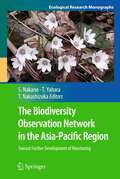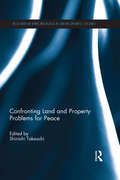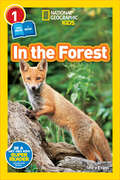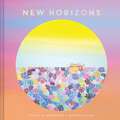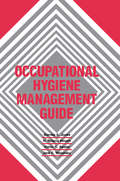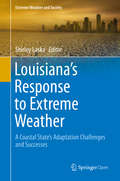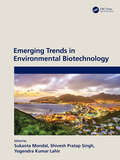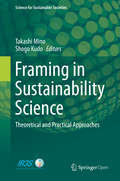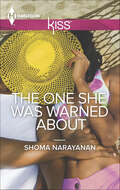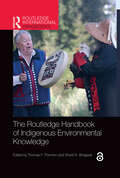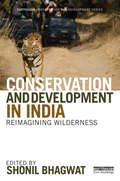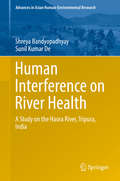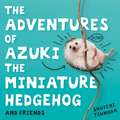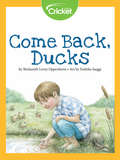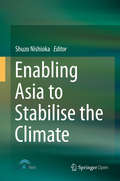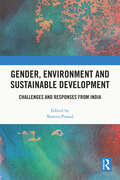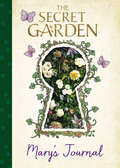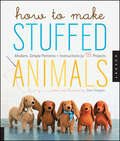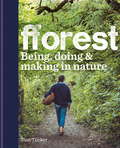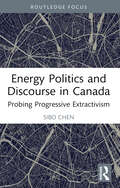- Table View
- List View
Aquatic Biodiversity Conservation and Ecosystem Services (Ecological Research Monographs)
by Shin-Ichi Nakano Tetsukazu Yahara Tohru NakashizukaThis volume examines the topic of local biodiversity conservation in the Asia-Pacific region, one of the most rapidly changing areas in the world. With a focus on aquatic systems, this book offers insight on the state of local biodiversity, challenges in management and conservation of biodiversity, and newly developed methods for monitoring biodiversity. In addition, because the service provided by an ecosystem for humans is interlinked with conservation, the final part is dedicated to evaluating the socioeconomic aspect of ecosystem services, with special reference to local biodiversity. In effect, all contributions provide information that is invaluable for effective conservation and sustainable use of biodiversity. This work will interest all stakeholders in biodiversity conservation, including policy makers, NPOs, NGOs, environment-related industries, and biodiversity researchers, not only in the Asia-Pacific region, but also across the entire globe.
The Biodiversity Observation Network in the Asia-Pacific Region
by Shin-Ichi Nakano Tetsukazu Yahara Tohru NakashizukaBiological diversity is important for ecosystem function and services, which in turn is essential for human well-being. Under the Convention on Biological Diversity, international efforts have been made to achieve a significant reduction in the current rate of biodiversity loss. The loss continues, however. The Asia-Pacific region includes both developing countries with high biodiversity and developed countries with sophisticated data collection and analyses, but only limited information about the status quo of biodiversity in this region has been available. Many Asia-Pacific countries have rapidly grown their economies and social infrastructures, causing a loss of biodiversity and requiring an urgent mandate to achieve a balance between development and conservation in the region. In December 2009, scientists successfully organized the Asia-Pacific Biodiversity Observation Network in the region, to establish a network for research and monitoring of ecosystems and biodiversity and to build a cooperative framework. The present volume is the first collection of information on biodiversity in the Asia-Pacific and represents a quantum step forward in science that optimizes the synergy between development and biodiversity conservation.
Confronting Land and Property Problems for Peace (Routledge Explorations in Development Studies)
by Shinichi TakeuchiThis collection clarifies the background of land and property problems in conflict-affected settings, and explores appropriate policy measures for peace-building. While land and property problems exist in any society, they can be particularly exacerbated in conflict-affected settings – characterized by unstable security, weak governance, loss of proper documentation as well as the return of refugees and Internally Displaced Persons. Unless these problems are properly addressed, they can destabilize fragile political order and hinder economic recovery. Although tackling land and property problems is an important challenge for peace-building, it has been relatively neglected in recent debates about liberal peace-building as a result of the strong focus on state-level institution building, such as security sector reforms and transitional justice. Using rich original data from eight conflict-affected countries, this book examines the topic from the viewpoint of State-society relationship. In contrast to previous literature, this volume analyses land and property problems in conflict-afflicted areas from a long-term perspective of state-building and economic development, rather than concentrating only on the immediate aftermath of the conflict. The long-term perspective enables not only an understanding of the root causes of the property problems in conflict-affected countries, but also elaboration of effective policy measures for peace. Contributors are area specialists and the eight case study countries have been carefully selected for comparative study. The collection applies a common framework to a diverse group of countries – South Sudan, Uganda, Rwanda, Burundi, Cambodia, Timor-Leste, Colombia, and Bosnia-Herzegovina.
In the Forest (Readers)
by Shira EvansWhat kinds of interesting critters live amongst the forest trees? Adult and child readers can find out together in this new Level 1 co-reader from National Geographic Kids, full of engaging photos and fun facts.
New Horizons: The Art of Wandering
by Shirin SahbaThis vibrant and entrancing book invites readers on a journey around the world. Artist and globetrotter Shirin Sahba celebrates the diversity of people, places, and traditions, and revels in the joy of the journey itself. In exquisitely detailed paintings, she captures fleeting moments and small treasures—a brightly colored sari fluttering in the breeze, a mother and child enjoying gelatos on a hot Italian day, the mesmerizing pattern of an antique Chinese carpet. Along the way, the artist shares reflections, inspirations, and stories, immersing readers in each new landscape. Packaged in a petite square and featuring a shimmering foil-stamped cover, this book makes a special gift for nomads, graduates, retirees, or anyone setting off in search of their own new horizons.
Research Scientist (Careers With Character #18)
by Shirley BrinkerhoffFind out what it takes to be a research scientist with character... Research scientists work to develop new products and techniques that improve human lives. These scientists can be: *Biochemists; *Botanists; *Marine biologists; *Microbiologists; *Physiologists; or *Zoologists. Whatever their field, researchers investigate ways to heal diseases, create new inventions, and explore the world around us. Professionals in this field need strong backgrounds in science and math--and equally strong characters. When researchers combine their desire to know more about the world with Integrity... Compassion... Diligence... And courage, they make the world a better place for us all to live. Find out about this exciting field. Read Research Scientist.
Occupational Hygiene Management Guide
by Shirley K. JonesApplicable worldwide, this valuable guide will enable you to develop, implement, and maintain the effective occupational health programs for your company needs. Authored by four experts responsible for environment, health, and safety at different General Electric businesses, it can help you avoid costly business as well as personal liabilities resulting from occupational health problems. This book describes the hazard recognition and control procedures essential to employee preventive health programs. Details the auditing and measurements process, and outlines the procedures necessary to monitor and ensure total effectiveness of your program, both immediate and long-term. A prime feature is the 1989-1990 TLVs (Threshold Limit Values) and BEIs (Biological Exposure Indices) published with permission of the American Conference of Governmental Industrial Hygienists.
Louisiana's Response to Extreme Weather: A Coastal State's Adaptation Challenges and Successes (Extreme Weather and Society)
by Shirley LaskaThis book is open access under a CC BY 4.0 license.This book takes an in-depth look at Louisiana as a state which is ahead of the curve in terms of extreme weather events, both in frequency and magnitude, and in its responses to these challenges including recovery and enhancement of resiliency.Louisiana faced a major tropical catastrophe in the 21st century, and experiences the fastest rising sea level. Weather specialists, including those concentrating on sea level rise acknowledge that what the state of Louisiana experiences is likely to happen to many more, and not necessarily restricted to coastal states. This book asks and attempts to answer what Louisiana public officials, scientists/engineers, and those from outside of the state who have been called in to help, have done to achieve resilient recovery. How well have these efforts fared to achieve their goals? What might these efforts offer as lessons for those states that will be likely to experience enhanced extreme weather? Can the challenges of inequality be truly addressed in recovery and resilience? How can the study of the Louisiana response as a case be blended with findings from later disasters such as New York/New Jersey (Hurricane Sandy) and more recent ones to improve understanding as well as best adaptation applications – federal, state and local?
Enchanted Childhoods: Growing Up in Yosemite, 1864-1945
by Shirley SargentReunion of people from Yosemite Elementary School, the meeting of over fifty alumni and their youthful experiences in Yosemite.
Emerging Trends in Environmental Biotechnology
by Sukanta Mondal Shivesh Pratap Singh Yogendra Kumar LahirThe environment is an all-encompassing component of the ecosystem of "Blue planet - the earth", made up of the hydrosphere, atmosphere and lithosphere. These three spheres have biotic and abiotic components which exhibit ecological homeostasis that provides the most appropriate survival chances for the members of biotic component and geochemical balance with abiotic components. This ecosystem is subjected to relatively harsh conditions, mostly created by the disastrous activities due to natural calamities and intentional and/or accidental anthropogenic activities. Biotechnology has become a potential tool to dissipate such environmental impacts because of the advancement it has undergone recently. Emerging Trends in Environmental Biotechnology is an outstanding collection of current research that integrates basic and advanced concepts of biotechnology such as genomics, proteomics, bioinformatics, sequencing, and imaging processes to improvise and protect the environment. This book is particularly attractive for scientists, researchers, students, educators and professionals in environmental science, agriculture, veterinary and biotechnology science. The book will enable them to solve the problems about sustainable development with the help of current innovative biotechnologies such as recombinant DNA technology and genetic engineering which have tremendous potential for impacting global food security, environmental health, human and animal health and overall livelihood of mankind. Features Presents easy-to-read chapters Information is presented in a very accessible and logical format Identifies and explores biotechnological approaches for environmental protection Encompasses biodegradation of hazardous contaminants, biotechnology in waste management, nanotechnology, and issues in environmental biotechnology research
Framing in Sustainability Science: Theoretical and Practical Approaches (Science for Sustainable Societies)
by Takashi Mino Shogo KudoThis open access book offers both conceptual and empirical descriptions of how to “frame” sustainability challenges. It defines “framing” in the context of sustainability science as the process of identifying subjects, setting boundaries, and defining problems. The chapters are grouped into two sections: a conceptual section and a case section. The conceptual section introduces readers to theories and concepts that can be used to achieve multiple understandings of sustainability; in turn, the case section highlights different ways of comprehending sustainability for researchers, practitioners, and other stakeholders. The book offers diverse illustrations of what sustainability concepts entail, both conceptually and empirically, and will help readers become aware of the implicit framings in sustainability-related discourses. In the extant literature, sustainability challenges such as climate change, sustainable development, and rapid urbanization have largely been treated as “pre-set,” fixed topics, while possible solutions have been discussed intensively. In contrast, this book examines the framings applied to the sustainability challenges themselves, and illustrates the road that led us to the current sustainability discourse.
The One She Was Warned About
by Shoma NarayananThere's no such thing as a reformed rebel! Shweta thought she would have the whole marriage-and-kids thing sorted by now. But she couldn't be more wrong-her love life's a wasteland! So when she bumps into Nikhil, the bad boy from her past who still sets her pulse racing, she can't resist flirting with danger.... Nikhil might have gone from zero to hero since they last met-although it's hard to believe from all the gossip about him!-but soon Shweta's hooked on the excitement he injects into her life...and on his spine-tingling touch! Perhaps the rumors are true-Nikhil really is as dangerous as his reputation....
The Routledge Handbook of Indigenous Environmental Knowledge (Routledge International Handbooks)
by Thomas F. Thornton Shonil A. BhagwatThis volume provides an overview of key themes in Indigenous Environmental Knowledge (IEK) and anchors them with brief but well-grounded empirical case studies of relevance for each of these themes, drawn from bioculturally diverse areas around the world. It provides an incisive, cutting-edge overview of the conceptual and philosophical issues, while providing constructive examples of how IEK studies have been implemented to beneficial effect in ecological restoration, stewardship, and governance schemes. Collectively, the chapters in the Routledge Handbook of Indigenous Environmental Knowledge cover Indigenous Knowledge not only in a wide range of cultures and livelihood contexts, but also in a wide range of environments, including drylands, savannah grassland, tropical forests, mountain landscapes, temperate and boreal forests, Pacific and Indian Ocean islands, and coastal environments. The chapters discuss the complexities and nuances of Indigenous cosmologies and ethno-metaphysics and the treatment and incorporation of IEK in local, national, and international environmental policies. Taken together, the chapters in this volume make a strong case for the potential of Indigenous Knowledge in addressing today’s local and global environmental challenges, especially when approached from a perspective of appreciative inquiry, using cross-cultural methods and ethical, collaborative approaches which limit bias and inappropriate extraction of IEK. The book is a guide for graduate and advanced undergraduate teaching, and a key reference for academics in development studies, environmental studies, geography, anthropology, and beyond, as well as anyone with an interest in Indigenous Environmental Knowledge.
Conservation and Development in India: Reimagining Wilderness (Earthscan Conservation and Development)
by Shonil BhagwatDespite decades of efforts to integrate conservation and development, India is torn between two very different worldviews of peoples’ place in the country’s natural environment. This book takes a critical look at nature conservation and poverty alleviation in India. It opens up discussion of the conservation–development nexus in a country that stands at a major crossroads, where forces of neoliberalism, globalisation and urbanisation are driving the future of India’s environment. As the book shows, conservation in India is increasingly concerned with creating ‘theme parks’ – inviolate, albeit isolated, spaces for wild nature, whereas development is concerned with fast-tracking the construction of built infrastructure while also rolling out nationwide welfare programmes – promising food, clothing and shelter for the poorest of the poor living in rural India. Conservation and development therefore have very different motivations and attempts to find a common ground have been fraught with challenges. This has been particularly so on the fringes of wildlife parks, where the rural poor come in frequent contact with wild animals to the detriment of both people and wildlife. Chapters are written by leading scholars on India to provide a vision of the future of Indian nature conservation. Whilst focused on India, the book will also be of interest to scholars and researchers of conservation and development more globally. As a ‘rising power’, the world’s eyes are set on India’s development trajectory and there is unprecedented interest in the course of development that the world’s largest democracy takes in the decades to come.
Human Interference on River Health
by Shreya Bandyopadhyay Sunil Kumar DeThis book examines in detail the health of India's Haora River, which is of vital importance as the lifeline of Agartala, the Capital City of Tripura. From its source in the Baramura Hills, the river debouches onto the rolling plains of Chandrasadhubari. Thousands of people between Chandrasadhubari and the boundary of Bangladesh have settled along the riverbanks and are directly dependent on the river. Since the 1970s the ever-growing population of the Haora River basin has been exerting tremendous pressure on the river. Several anthropogenic activities affect the river, increasing sedimentation and pollution, and are leading the Haora River toward its dying phase. This book presents the problems related to the overall health of the Haora River and discusses some proposals for restoring the ecological balance and geo-political stability of this strategically important part of the country.
The Adventures of Azuki the Miniature Hedgehog and Friends
by Shuichi TsunodaAzuki, the much-loved Japanese miniature hedgehog who became an Instagram sensation, with over 407,000 followers, sadly died on the 20th January 2019. His daughter, Monaka, born on the 8th April 2018, is following in her father's footsteps. This is a collection of adorable photographs of Azuki, Monaka and their friends baking, playing pool, reading and enjoying other mini-adventures. In his heyday, Azuki was a mainstay of Bored Panda and was featured on Time magazine's website. New York magazine called him 'the only pure thing left in this world', and he appeared in the pages of the Independent and the Sun. He also had thousands of fans in Australia and New Zealand. <P><P>The Adventures of Azuki the Miniature Hedgehog and Friends is the perfect gift book for the animal lover in your life who is over dogs and cats and into hedgehogs, for anyone who clicks on Cute Overload for a break from the news, and for Azuki and daughter Monaka's still-growing fan base.' <P><P>In Japan, hedgehogs are thought to be a type of rat, and generally don't have a good image,' Tsunoda explains. 'By publishing a photo book, I aim to raise awareness.'
Come Back, Ducks
by Shulamith Levey OppenheimA young boy watches the ducks in his family's pond and wonders why they've suddenly left one day.
Enabling Asia to Stabilise the Climate
by Shuzo NishiokaThis book presents good practices in Asia and ASEAN countries for effectively promoting advances in response to climate change, which can help to achieve sustainable development in Asia and around the world. As a proposal, the aim is to influence the discussions at COP 21 by providing a positive agenda with concrete actions from an Asian perspective. The book is divided into three parts. Part 1 describes the greenhouse gas (GHG) reduction scenario from an Asian perspective and in line with global 2 ° targets. Based on modeling analysis, the studies demonstrate the theoretical potentials and send the policymakers at COP 21 the positive message that "Asia can reach the target. " As Asian countries vary in terms of their economic strength, country-specific scenario studies for the two giants China and India as well as for Japan and Vietnam are introduced to show the different approaches for each country. Part 2 shows successful examples of how modeling analysis are reflected in actual policy development, which provides practical guidelines to help policymakers develop their own roadmaps with stakeholder dialogue, not only in Asia but also in other regions of the world. The Nationally Appropriate Mitigation Action (NAMA) roadmap development in Thailand as well as the Iskandar Malaysia project show at the country and city level how researchers and policymakers are working closely to succeed. Part 3 focuses on a number of sector-specific activities including transportation, forestry, capacity development, and inventory work in Asia. Rather than discussing the Low Carbon Society (LCS) concept in detail, the respective chapters highlight unique, concrete, and practically applicable examples from Asia, showing how Asian countries are addressing climate change mitigation issues in a collaborative manner, an approach that can be replicated in other regions. While the ultimate goal of this book is to facilitate international climate regime making, local government and international organizations (United Nations, World Bank, and others) officers, researchers, international NGO/NPOs, consultants, students (particularly those studying international relationships or environmental studies), as well as reporters will find this book useful in broadening their understanding of low-carbon development in Asia.
Gender, Environment and Sustainable Development: Challenges and Responses from India
by Shweta PrasadThis book studies environment and sustainable development from the perspective of gender. It focuses on three major themes, including sustainability of development practices, policy perspectives on environmental management and climate change and its gendered impact. It includes contributions from academicians working across disciplines and practitioners working at the grassroots levels. The book addresses issues facing India amid a growing global environmental crisis and suggests policy measures for environmental protection and to improve the quality of life of its inhabitants. Lucid and topical, the volume will be an indispensable resource for students, researchers of gender, environment and sustainable development, sociology and public policy. It will also be a great resource for advocacy groups, non-governmental organisations (NGOs) and policymakers working in the area.
The Secret Garden: Mary's Journal (The Secret Garden Movie)
by Sia DeyBased on the upcoming major motion picture and inspired by the original classic novel by Frances Hodgson Burnett, this full-color 96-page journal expands on the cinematic world of The Secret Garden through the point of view of Mary Lennox. Featuring unique content across both text and imagery, this journal format will open the reader's eyes to a more personal take on the events from the film.When ten-year-old orphan Mary Lennox is sent to live with her reclusive uncle Archibald (Colin Firth) and his strict housekeeper Mrs. Medlock (Julie Walters) in a mysterious Yorkshire manor, she feels lonelier than ever before. But her curiosity and determination lead her to disobey the adults and explore the forbidding house.While roaming the grounds of the manor she discovers an enchanted and boundless garden that has been hidden for years and reflects her limitless imagination. With local boy Dickon, her sick cousin Colin, and a playful stray dog, Mary embraces this world of wonder, unlocking secrets from the past and revealing a whole new life of hope and friendship for her to discover.
How to Make Stuffed Animals: Modern, Simple Patterns + Instructions for 18 Projects
by Sian KeeganLearn how to make eighteen stuffed animal projects with original sewing patterns and illustrated instructions from this easy-to-use craft guide.With a complete overview of techniques and materials, How to Make Stuffed Animals shows that making these cuddly creatures is fun, addictive, and much easier than one would think. Anyone who has completed the most basic of sewing projects can master the projects in this book, and these cute creations can be used as decorative objects for the home or as great handmade gifts.Inside, you’ll find adorable animals like:A squirrel holding an acornA grizzly bearA raccoonA horseA bird mobileCute caninesFurry felinesAnd many moreExplore a comprehensive range of animals in a modern and simple style with How to Make Stuffed Animals!
Fforest: Being, Doing & Making in Nature
by Sian TuckerCalming to the soul and good for us all, spending time outdoors offers us precious breathing space away from the stresses and strains of modern life. This inspirational guide celebrates the life enhancing effect of nature and encourages you to try the pursuits that would have been second nature to previous generations - from walking in the dark with only the light of the moon and stars to guide you, to wild swimming, forest bathing and sleeping under canvas. It will inspire you to re-discover the joy of sky and clouds, night and tides, stars and silence. <P><P>Photography by Finn Beales
Coastal Architectures and Politics of Tourism: Leisurescapes in the Global Sunbelt
by Sibel BozdoǧanThis volume offers a critical and complicated picture of how leisure tourism connected the world after the World War II, transforming coastal lands, traditional societies, and national economies in new ways. The 21 chapters in this book analyze selected case studies of architectures and landscapes around the world, contextualizing them within economic geographies of national development, the geopolitics of the Cold War, the legacies of colonialism, and the international dynamics of decolonization. Postwar leisure tourism evokes a rich array of architectural spaces and altered coastal landscapes, which is explored in this collection through discussions of tourism developments in the Mediterranean littoral, such as Greece, Turkey, and southern France, as well as compelling analyses of Soviet bloc seaside resorts along the Black Sea and Baltic coasts, and in beachscapes and tourism architectures of western and eastern hemispheres, from Southern California to Sri Lanka, South Korea, and Egypt. This collection makes a compelling argument that "leisurescapes," far from being supra-ideological and apolitical spatial expressions of modernization, development, and progress, have often concealed histories of conflict, violence, social inequalities, and environmental degradation. It will be of interest to architectural and urban historians, architects and planners, as well as urban geographers, economic and environmental historians.
Coastal Architectures and Politics of Tourism: Leisurescapes in the Global Sunbelt
by Sibel BozdoǧanThis volume offers a critical and complicated picture of how leisure tourism connected the world after the World War II, transforming coastal lands, traditional societies, and national economies in new ways.The 21 chapters in this book analyze selected case studies of architectures and landscapes around the world, contextualizing them within economic geographies of national development, the geopolitics of the Cold War, the legacies of colonialism, and the international dynamics of decolonization. Postwar leisure tourism evokes a rich array of architectural spaces and altered coastal landscapes, which is explored in this collection through discussions of tourism developments in the Mediterranean littoral, such as Greece, Turkey, and southern France, as well as compelling analyses of Soviet bloc seaside resorts along the Black Sea and Baltic coasts, and in beachscapes and tourism architectures of western and eastern hemispheres, from Southern California to Sri Lanka, South Korea, and Egypt. This collection makes a compelling argument that "leisurescapes," far from being supra-ideological and apolitical spatial expressions of modernization, development, and progress, have often concealed histories of conflict, violence, social inequalities, and environmental degradation. It will be of interest to architectural and urban historians, architects and planners, as well as urban geographers, economic and environmental historians.
Energy Politics and Discourse in Canada: Probing Progressive Extractivism (Routledge Focus on Communication Studies)
by Sibo ChenThis book examines the discourse around the intricate economic, political, and ideological struggles underlying Canadian fuel extractivism. Focusing on the two contending discourse coalitions formed by supporters and opponents of British Columbia’s liquefied natural gas (LNC) industry, the book explores the ongoing debates around the issue. The book’s in-depth investigation of the BC LNG controversy identifies progressive extractivism as an increasingly popular policy/discursive paradigm adopted by fossil fuel advocates to legitimize unconventional fossil fuels in an era of intensifying climate crisis. It also highlights the importance of debunking the misleading “jobs versus the environment” dichotomy in mobilizing public opposition to carbon-intensive economic growth. This deeply nuanced look at energy discourse in public policy will have resonance for scholars and students working in the areas of environmental communication, rhetoric, discourse analysis, public policy, and climate change rhetoric.

